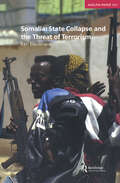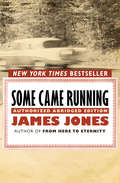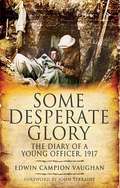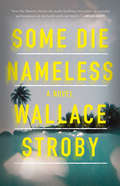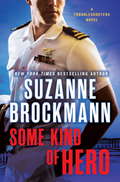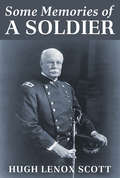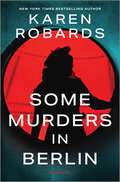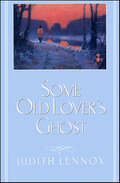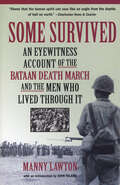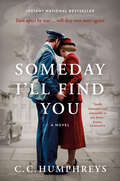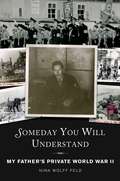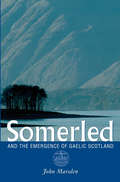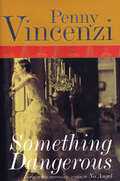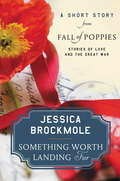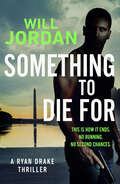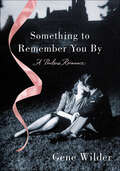- Table View
- List View
Somalia: State Collapse And The Threat Of Terrorism (Adelphi series #364)
by Ken MenkhausThis work explores Somalia's state collapse and the security threats posed by Somalia's prolonged crisis. Communities are reduced to lawlessness, and the interests of commercial elites have shifted towards rule of law, but not a revived central state. Terrorists have found Somalia inhospitable, using it mainly for short-term transshipment.
Some Came Running
by James JonesJames Jones's saga of life in the American Midwest, newly revised five decades after it was first publishedAfter the blockbuster international success of From Here to Eternity, James Jones retreated from public life, making his home at the Handy Writers' Colony in Illinois. His goal was to write something larger than a war novel, and the result, six years in the making, was Some Came Running, a stirring portrait of small-town life in the American Midwest at a time when our country and its people were striving to find their place in the new postwar world. Five decades later, it has been revised and reedited under the direction of the Jones estate to allow for a leaner, tighter read. The result is the masterpiece Jones intended: a tale whose brutal honesty is as shocking now as on the day it was first published. This ebook features an illustrated biography of James Jones including rare photos from the author's estate.
Some Desperate Glory
by Emily Tesh'This book is astoundingly good. An explosive and extraordinary story that I couldn't stop reading and will never forget' Everina Maxwell, author of Winter's OrbitSome Desperate Glory the highly anticipated debut novel from Astounding Award and World Fantasy Award-Winner, Emily Tesh; a thrillingly told space opera about the wreckage of war, the family you find, and the path you must forge when every choice is stripped from you.All her life, Kyr has trained for the day she can avenge the destruction of planet Earth. Raised on Gaea Station alongside the last scraps of humanity, she is one of the best warriors of her generation, the sword of a dead planet. Then Command assigns her brother to certain death and relegates her to the nursery to bear sons, and she knows she must take humanity's revenge into her own hands. Alongside her brother's brilliant but seditious friend and a lonely, captive alien, Kyr must escape from everything she's ever known. If she succeeds, she will find a universe far more complicated than she was taught and far more wondrous than she could ever have imagined'A profoundly humane and brilliantly constructed space opera that will have you cheering, swearing, laughing, and ugly-crying. It's perfect' Alix E. Harrow, New York Times-bestselling author of The Once and Future Witches'Masterful, audacious storytelling. Relentless, unsentimental, a completely wild ride' Tamsyn Muir, New York Times-bestselling author of The Locked Tomb series'Raw and action packed . . . This riveting adventure deserves a space on shelves alongside genre titans like Ursula K. Le Guin and Octavia Butler'Publishers Weekly (starred review)Reader reviews:'Worth every page, every tear, every late night staying up to finish it. I hope you love this book as much as I do' 'For the life of me I could. not. put. it. down''As brilliantly plotted as Ann Leckie's Ancillary Justice, with characters as vivid as Martha Wells' Murderbot''I am legitimately not exaggerating when i say this may be my favorite book i've read in the last ten years''HOLY MOTHER OF GOD I WAS NOT AT ALL PREPARED AND I AM ETERNALLY OBSESSED'
Some Desperate Glory: The Diary of a Young Officer, 1917
by Edwin Campion Vaughan&“An officer&’s diary hidden away for 40 years reveals the horrors of World War One in harrowing detail.&” —The SunSome Desperate Glory charts the progress of an enthusiastic and patriotic young officer who marched into battle with Palgrave&’s Golden Treasury—a collection of English poems—in his pack. Intensely honest and revealing, his diary evokes the day-to-day minutiae of trench warfare: its constant dangers and mind-numbing routine interspersed with lyrical and sometimes comic interludes. Vividly capturing the spirit of the officers and men at the front, the diary grows in horror and disillusionment as Vaughan&’s company is drawn into the carnage of Passchendaele from which, of his original happy little band of 90 men, only 15 survived.&“This diary of a few months in the life of a young officer on the Western Front in 1917 deserves to rank close behind Graves, Owen, Sassoon, among the most brilliant and harrowing documents of that devastating period.&” —Max Hastings, author of Vietnam: An Epic Tragedy, 1945-1975&“This stark WW I diary by a 19-year-old subaltern in the British army begins with an account of his eager departure for the western front, and ends eight months later with an awesome description of the battle of Ypres in which most of his company died.&” —Publishers Weekly
Some Desperate Glory: The Sunday Times bestseller
by Emily Tesh'Masterful, audacious storytelling. Relentless, unsentimental, a completely wild ride'Tamsyn Muir, New York Times-bestselling author of Gideon the Ninth'Deserves a space on shelves alongside genre titans like Ursula K. Le Guin and Octavia Butler'Publishers Weekly (starred review)A thrillingly told space opera about the wreckage of war, the family you find, and the path you must forge when every choice is stripped from you. Some Desperate Glory is the highly anticipated debut novel from Astounding Award and World Fantasy Award-Winner, Emily Tesh.All her life, Kyr has trained for the day she can avenge the destruction of planet Earth. Raised on Gaea Station alongside the last scraps of humanity, she is one of the best warriors of her generation, the sword of a dead planet.Then Command assigns her brother to certain death and relegates her to the nursery to bear sons, and she knows she must take humanity's revenge into her own hands. Alongside her brother's brilliant but seditious friend and a lonely, captive alien, Kyr must escape from everything she's ever known. If she succeeds, she will find a universe far more complicated than she was taught and far more wondrous than she could ever have imagined'A profoundly humane and brilliantly constructed space opera that will have you cheering, swearing, laughing, and ugly-crying. It's perfect' Alix E. Harrow, New York Times-bestselling author of The Once and Future Witches'This book is astoundingly good. An explosive and extraordinary story that I couldn't stop reading and will never forget' Everina Maxwell, author of Winter's OrbitReader reviews:'Worth every page, every tear, every late night staying up to finish it. I hope you love this book as much as I do' 'For the life of me I could. not. put. it. down''As brilliantly plotted as Ann Leckie's Ancillary Justice, with characters as vivid as Martha Wells' Murderbot''I am legitimately not exaggerating when I say this may be my favourite book I've read in the last ten years''HOLY MOTHER OF GOD I WAS NOT AT ALL PREPARED AND I AM ETERNALLY OBSESSED'
Some Die Nameless
by Wallace StrobyAn ex-mercenary and an embattled journalist find themselves unlikely allies against a corrupt defense contractor in this "noir for modern times" (Ace Atkins).Ray Devlin is retired, living a simple life off the grid in Florida, when a visit from an old colleague stirs some bad memories--and ends with a gunshot. Soon Devlin is forced to again face a past he'd hoped to leave behind, as a member of a mercenary force that helped put a brutal South American dictator into power. Tracy Quinn is an investigative reporter at a struggling Philadelphia newspaper decimated by layoffs and cutbacks. Then one day what appears to be a straightforward homicide--a body left in an abandoned rowhouse--draws her and Devlin together, and ultimately enmeshes both in a conspiracy that stretches over twenty years and reaches to the highest levels of the U.S. government.Before long, they're both the targets of a ruthless assassin haunted by his own wartime experiences. For Devlin, it could all mean a last shot at redemption. For Tracy, the biggest story of her career might just cost her life.
Some Do Not...: Large Print
by Ford Madox FordSome Do Not...' is Ford Madox Ford&’s masterpiece, landmark novel about the World war One and the events leading up to it. He perfectly captures the chaos and insanity that enveloped the word. Christopher Tietjens is an officer and a gentleman. We follow Tietjens as he tries to navigate a marriage fraught with infidelity and a war fraught with savagery, each tears him apart in it&’s own way. A stunnly complex and poignant novel. &“The finest novel about the First World War&” — Anthony Burgess
Some Kind of Hero: A Troubleshooters Novel (Troubleshooters #19)
by Suzanne BrockmannThe Troubleshooters return in the latest thriller from New York Times bestselling author Suzanne Brockmann! Some Kind of Hero showcases Brockmann’s signature white-knuckle suspense, romantic twists, and sexy Navy SEALs. Navy men don’t come tougher than Lieutenant Peter Greene. Every day he whips hotshot SEAL wannabes into elite fighters. So why can’t he handle one fifteen-year-old girl? His ex’s death left him a single dad overnight, and very unprepared. Though he can’t relate to an angsty teen, he can at least keep Maddie safe—until the day she disappears. Though Pete’s lacking in fatherly intuition, his instinct for detecting danger is razor sharp. Maddie’s in trouble. Now he needs the Troubleshooters team at his back, along with an unconventional ally. Romance writer Shayla Whitman never expected to be drawn into a real-world thriller—or to meet a hero who makes her pulse pound. Action on the page is one thing. Actually living it is another story. Shay’s not as bold as her heroines, but she’s a mother. She sees the panic in her new neighbor’s usually fearless blue eyes—and knows there’s no greater terror for a parent than having a child at risk. It’s an ordeal Shay won’t let Pete face alone. She’s no highly trained operative, but she’s smart, resourceful, and knows what makes teenagers tick. Still, working alongside Pete has its own perils—like letting the heat between them rise out of control. Intimate emotions could mean dangerous, even deadly, consequences for their mission. No matter what, they must be on top of their game, and playing for keeps . . . or else Pete’s daughter may be gone for good.Advance praise for Some Kind of Hero“Nobody mixes suspenseful adventure and heart-melting romance like Suzanne Brockmann.”—USA Today bestselling author Sarina Bowen “Nobody does it better! Some Kind of Hero is Suzanne Brockmann at the top of her game, with a story full of heartstopping action and genuine, funny, heartfelt emotion.”—New York Times bestselling author Virginia Kantra “In classic Brockmann style, Some Kind of Hero does not shy away from the controversies of our times. Instead, it faces them head on, delivering a thought-provoking, high-octane love story with a hero and heroine one can’t help but root for. Prepare to be blown away.”—USA Today bestselling author Farrah Rochon “Delicious sexual tension and a fast-paced plot made me want Some Kind of Hero to last way past the final page.”—USA Today bestselling author Megan Erickson “Brockmann is a master at romantic suspense. Sexy, smart, and completely original, Some Kind of Hero is not to be missed.”—HelenKay Dimon, award-winning author of the Tough Love series “The writer in me can’t believe that Brockmann keeps getting better with every book. The reader in me loves it!”—M. L. Buchman, author of The Night Stalkers series and Delta Force series“Fast-paced suspense and a to-die-for hero! This book will be a new favorite for Brockmann fans.”—New York Times bestselling author Elle Kennedy “A thought-provoking, deeply satisfying romance from a master of the genre.”—Kirkus Reviews (starred review)
Some Memories of a Soldier
by Hugh Lenox ScottSome Memories of a Soldier, first published in 1928, is the autobiography of influential U.S. Army General Hugh Lenox Scott (1853-1934). This autobiography of General Hugh L. Scott was published in 1929. General Scott's career was impressive and influential to say the least. After graduating from West Point, Scott joined the Cavalry and filled one of the many vacancies after Custer's men were destroyed. In the Indian Wars, Scott learned the Sioux language and then also became fluent in a more widespread sign language that was used by several tribes. He successfully mediated several conflicts using these skills. In addition to spending time out West, he joined Leonard Wood in Cuba were he was a leading figure in the occupation. After that, he led troops in the Philippines where he was given one of the most challenging assignments that positioned him in Moro territory. By the end of his tenure there, the Moro people respected him so much that they gave him their most prized possession which was the first Koran ever to reach the islands. Scott describes these adventures as well as his duty in Fort Sill overseeing Geronimo's imprisonment, his superintendent duties at West Point, and his time as Chief of Staff as the country plunged into World War I. of particular interest to me, was the controversial friendship which he forged with Francisco Villa. When Villa attacked the US, he was forced to send Pershing into Mexico to disband the Villistas. Scott would ultimately choose Pershing to lead World War I and he developed the basics behind the selective service system. In short, this autobiography has something for everyone. The reader explores the adventure that was Scott's life. While Scott's name is far from being a household name, he saved many lives and should be remembered as a true hero. "Blessed are the Peacemakers" Included are 50 pages of photographs.
Some Murders in Berlin: A WWII Historical Fiction Novel
by Karen RobardsThis pulse-pounding, brilliantly twisting new historical thriller is a gripping tale that will leave you questioning everything.September 1943: Berlin is the heart of darkness—and the last place Dr. Elin Lund wishes to be. An expert in psychological profiling, she&’s been summoned from Copenhagen to investigate the gruesome murders of eight young women. Even in the midst of unspeakable evil, these killings stand apart. And with her homeland now under Nazi occupation and a young son to protect, Elin can&’t refuse such a request.Homicide Detective Kurt Schneider, head of the criminal police unit, is grudging in his welcome. The orders to find the killer come from the top, and to fail means death. The stakes are too high to risk any mistakes—or to trust a stranger. Yet the pair, trapped in an uneasy partnership, each has expertise the other needs. And Schneider, like Elin, is clearly guarding secrets of his own.Racing to complete the investigation and return to her son, Elin feels the net tightening. Every sliver of evidence reveals a killer infinitely more dangerous, and more powerful, than anyone suspected. And in drawing closer to the terrifying truth, Elin has unwittingly made herself his new obsession…A serial killer on the loose. A profiler with a hidden past. Trust is a luxury no one can afford.
Some Old Lover's Ghost
by Judith Lennox“Believable characters and a tale rife with shocking scandals make for a chilling mystery” in this family saga from an international bestselling author (Publishers Weekly).Rebecca Bennett, thirty-one, financially strapped and reeling from a disastrous love affair, has just taken on the biggest project of her career: writing the biography of Dame Tilda Franklin, considered England's angel to needy children.Mining the past of this distinguished child welfare activist, Rebecca is amazed to discover a history riddled with the passion and pain of mysterious kin and unpredictable love. Delving further into Dame Tilda's life, Rebecca finds parallels with her own experience and begins to regard this woman as a kindred spirit. Soon a romance blossoms between Rebecca and Tilda's grandson, Patrick, and she is drawn even closer to the family. Yet, just as their relationship begins to grow, Rebecca uncovers a family secret that threatens to destroy her newfound love.Set against the stark beauty of the Fen country and peopled with memorable characters, Some Old Lover's Ghost is an addictive novel of tragedy, recovery, healing, and love that will raise you up and touch your heart.“Readers of Rosamunde Pilcher and Angela Thirkell should enjoy this very entertaining novel.” —Library Journal“A fulfilling, enriching story.” —Booklist“Casts an inviting spell, seducing the reader.” —Kirkus Reviews
Some Reflections Upon Marriage
by Mary AstellPublished anonymously in 1700, Some Reflections upon Marriage lamented the inequities of the institution of marriage and reasoned against it with both traditional and innovative arguments. Mary Astell's tract, written in response to an infamous divorce case, forcefully argued against the grim but all-too-common prospect of a marriage of necessity to a man in search of power, money, or a trophy wife. Astell proposed education as the solution to women's second-class status, stating that knowledge alone could lead to a partnership based on friendship and respect. "Let us learn to pride ourselves in something more excellent than the invention of a fashion," she wrote, and her well-reasoned arguments soon won her a wide readership.
Some Sunny Day (Lavender Road 2)
by Helen CareyIn Helen Carey's poignant and nostalgic novel SOME SUNNY DAY, it's 1940, and two young women are growing up in a world full of drama and danger. Perfect reading for fans of Kate Thompson and Donna Douglas.September 1940As Luftwaffe bombs rain from the skies over London, the women of Lavender Road are fighting their own battles.Shy Katy Parsons has always been sheltered by her over-protective parents. The war is her chance to see life from beyond her bedroom window. Enrolling as a nurse was always her dream, but the reality is tougher than she ever imagined. And falling in love isn't all plain sailing either...Privileged Louise Rutherford secretly hoped the war would bring her some fun and romance. But far it has brought her pain and grief, and now she has a secret... something her strict father must never find out about.London during the Blitz is a dangerous place to live but the Lavender Road residents never stop believing their sunny day will come.
Some Sunny Day (Lavender Road 2)
by Helen CareyIn Helen Carey's poignant and nostalgic novel SOME SUNNY DAY, it's 1940, and two young women are growing up in a world full of drama and danger. Perfect reading for fans of Kate Thompson and Donna Douglas.September 1940As Luftwaffe bombs rain from the skies over London, the women of Lavender Road are fighting their own battles.Shy Katy Parsons has always been sheltered by her over-protective parents. The war is her chance to see life from beyond her bedroom window. Enrolling as a nurse was always her dream, but the reality is tougher than she ever imagined. And falling in love isn't all plain sailing either...Privileged Louise Rutherford secretly hoped the war would bring her some fun and romance. But far it has brought her pain and grief, and now she has a secret... something her strict father must never find out about.London during the Blitz is a dangerous place to live but the Lavender Road residents never stop believing their sunny day will come.
Some Survived: An Eyewitness Account of the Bataan Death March and the Men Who Lived through It
by John Toland Manny LawtonThis true account by a WWII veteran taken prisoner by the Japanese “shows that the human spirit can soar like an eagle from the depths of hell on earth” (The Post and Courier, Charleston, South Carolina). Manny Lawton was a twenty-three-year-old army captain on April 8, 1942, when orders to surrender to the Japanese forces invading the Philippines arrived. The next day, he and his fellow American and Filipino prisoners set out on the infamous Bataan Death March—a forced six-day, sixty-mile trek under a broiling tropical sun during which approximately eleven thousand men died or were bayoneted, clubbed, or shot to death by the Japanese. As terrible as the Death March was, for Manny Lawton and his comrades it was only the beginning. When the war ended in August 1945, it is estimated that some 57 percent of the American troops who had surrendered on Bataan had perished. Yet this is not a chronicle of despair. It is, instead, the story of how men can suffer even the most desperate conditions and, in their will to retain their humanity, triumph over appalling adversity. An epic of quiet heroism with an introduction by historian John Toland, Some Survived is a harrowing and inspiring tale—and “an honorable and absorbing testament to the courage of many” (TheState).
Someday I'll Find You
by C.C. HumphreysFor readers of The Nightingale and Lilac Girls, a dazzling novel about Ilse, a spy, and Billy, a pilot, who fall in love but are wrenched apart during World War II, and must find their way back to each other--from bestselling author C.C. Humphreys.When Billy Coke steps onto the streets of London one December evening in 1940, he has no idea he is stepping to his fate. As Hitler's bombers come close to burning the city down, Billy meets the woman who will change the course of his life: Ilse Magnusson, a musician from Norway, but also something more--a spy in training.Escaping the Blitz for three days, she and Billy drive, quarrel, conceal, reveal . . . and fall finally, fully, in love.Now they must part, each to fight the war their own way. Billy, a Canadian Spitfire pilot, to duel with the Luftwaffe over North Africa and the Med. Ilse to return to her conquered country, ingratiate herself with the Nazi elite--which includes her beloved father--and send vital intelligence back to Britain.They know that the odds of both of them surviving are poor. All they can hope is that the other does survive--and that someday they find each other again.From decadent pre-war Berlin to the atrocity at Guernica, from dogfights over Sicily to an Oslo ground under the German jackboot, through small victories and bitter losses, this is the story of a man and a woman at war. A tale of causes and compromises, heroism and betrayal. Of choices made, with consequences unforeseen. And finally, how sometimes . . . love can give you a second chance.
Someday I'll Find You: a novel
by C.C. HumphreysThis instant national bestseller, for readers of The Nightingale and Lilac Girls, is a dazzling novel about a spy and a pilot who fall in love but are wrenched apart during World War II, and must find their way back to each other.When Billy Coke steps onto the streets of London one December evening in 1940, he has no idea he is stepping to his fate. As Hitler's bombers come close to burning the city down, Billy meets the woman who will change the course of his life: Ilse Magnusson, a musician from Norway, but also something more--a spy in training.Escaping the Blitz for three days, she and Billy drive, quarrel, conceal, reveal . . . and fall finally, fully, in love.Now they must part, each to fight the war their own way. Billy, a Canadian Spitfire pilot, to duel with the Luftwaffe over North Africa and the Med. Ilse to return to her conquered country, ingratiate herself with the Nazi elite--which includes her beloved father--and send vital intelligence back to Britain.They know that the odds of both of them surviving are poor. All they can hope is that the other does survive--and that someday they find each other again.From decadent pre-war Berlin to the atrocity at Guernica, from dogfights over Sicily to an Oslo ground under the German jackboot, through small victories and bitter losses, this is the story of a man and a woman at war. A tale of causes and compromises, heroism and betrayal. Of choices made, with consequences unforeseen. And finally, how sometimes . . . love can give you a second chance.
Someday You Will Understand: My Father's Private World War II
by Nina Wolff FeldWalter Wolff was the son of a Jewish merchant family that fled their German home when the Nazis came to power and took refuge in Brussels, Belgium. On the eve of the German invasion, in May 1940, the family began its second escape. Their sixteen-month odyssey took them through the chaos of battle in France and the dangers of living clandestinely as Jews in occupied territory, before they finally boarded the notorious freighter SS Navemar in Cadiz, Spain, to be among the last Jewish refugees admitted to the United States before Pearl Harbor.Within two years of his arrival in the States, Walter was ready to take the fight back to the Nazis as a soldier in the U.S. Army. Trained for the Intelligence Corps at Camp Ritchie, he was sent first to Italy and then to Germany and Austria, where he interrogated POWs for potential prosecution as war criminals at Nuremburg. At the same time, on his travels in Europe he returned to the confiscated properties of his extended family, throwing out the occupiers and reclaiming ownership. Telling the rousing story of a Jewish boy who fled persecution and returned to prosecute the Nazi oppressors, Walter Wolff's daughter Nina has reconstructed these events from family lore and her father's own cache of more than 700 wartime letters and 200 photographs, which he revealed to her shortly before he died.
Someone Like You: A Romance Novel
by Susan MalleryFrom the #1 New York Times–bestselling author of Falling for Gracie: “When you think of passion, drama and heartwarming stories, think Susan Mallery.” —RT Book Reviews (Top Pick)Jill Strathern left town for the big city and never looked back—until she returned home years later to run a small law practice. It turns out her childhood crush, Mac Kendrick, a burned-out LAPD cop, has also come back to sleepy Los Lobos. Even though Mac rejected her back in high school, Jill can’t deny the attraction she still feels for him.Now Jill and Mac are tangled in enough drama to satisfy the most jaded L.A. denizens—Mafia dons, social workers, angry exes and one very quirky eight-year-old make even the simplest romance complicated. And it all goes to prove that when it comes to affairs of the heart, there’s no place like home. An unlikely pair . . . but a perfect match.Praise for Falling for Gracie“Susan Mallery really is a small-town romance goddess . . . Falling for Gracie was a great example of everything there is to love about Susan Mallery romances.” —Cheeky Reads“Filled with humor, warmth and strong characters.” —Contemporary Romance Writers“The interactions and the intense emotions between the characters make for a fun and interesting read.” —All About Romance
Somerled: And the Emergence of Gaelic Scotland
by John MarsdenAnexamination the life of the mid-12th-century Gaelic-Norse lord and his cultural and historical significance, by the author of Galloglas. Through almost eight hundred years, Somerled of Argyll has been variously denounced as an intractable rebel against his rightful king and esteemed as the honored ancestor of the later medieval Lord of the Isles. But now he can be recognized as a much more complex figure of major prominence in twelfth-century Scotland and of truly landmark significance in the long history of the Gael. In this book, author John Marsden investigates Somerled&’s emergence in the forefront of the Gaelic-Norse aristocracy of the western seaboard, his part in Gaeldom&’s challenge to the Canmore kings of Scots, his war on the Manx king of the Isles, his importance for the church on Iona, and his extraordinary invasion of the Clyde, which was cut short by his violent death at Renfrew in 1164. Marsden also demonstrates how almost everything that is known of or has been claimed for Somerled reflects the same characteristic fusion of Norse and Celt that binds the cultural roots of Gaeldom. It is this recognition that has led Marsden to propose Somerled&’s wider historical importance as the personality who most represents the first fully-fledged emergence of the medieval Celtic-Scandinavian cultural province from which is directly descended the Gaelic Scotland of today.
Something Dangerous
by Penny VincenziSecond in the Spoils of Time trilogy. “Vincenzi continues the lush multigenerational and transatlantic family saga she began in the bestselling No Angel.” —BooklistThe dazzling Lytton twins, Adele and Venetia, are born into the great Lytton publishing empire. In 1928, on their eighteenth birthday, they are rich and admired, with a confidence verging on arrogance. But the specter of Nazi Germany is growing . . . Gradually their privileged world darkens in unimaginable ways—but it is not just the twins whose lives have been irrevocably changed. Barty Miller, rescued from the London slums in babyhood by Celia Lytton, is clever, ambitious, and a complete contrast to the twins—and she faces temptation of the most unexpected kind . . . “As family secrets and the Nazis both threaten to crush the house of Lytton, Vincenzi tightens her grip on readers, churning out surprising twists that not only resolve current conflicts but promise delicious future crises.” —Publishers WeeklyPraise for Penny Vincenzi“The doyenne of the modern blockbuster.” —Glamour“Soap opera? You bet—but with her well-drawn characters and engaging style, Vincenzi keeps things humming.” —People“Nobody writes smart, page-turning commercial women’s fiction like Vincenzi.” —USA Today“Will draw you in against your better judgment and keep you awake reading all night.” —The Boston Globe“Vincenzi does it again with another captivating and entertaining family saga that combines power, riches, lies, and greed . . . For fans of Barbara Taylor Bradford and Danielle Steel.” —Library Journal
Something Of Myself: For My Friends Known And Unknown (Rudyard Kipling Centenary Editions Ser.)
by Rudyard KiplingKipling was one of the most popular writers in English, both prose and verse, in the late 19th and early 20th centuries. Henry James famously said of him: "Kipling strikes me personally as the most complete man of genius (as distinct from fine intelligence) that I have ever known." In 1907, he was awarded the Nobel Prize in Literature. This book is the world famous autobiography that Kipling penned toward the end of his life and sheds much detail on his life, career, travels and influences.
Something Worth Landing For: A Short Story from Fall of Poppies
by Jessica BrockmoleSomething Worth Landing For has descriptive copy which is not yet available from the Publisher.
Something to Die For (Ryan Drake)
by Will JordanA British secret agent has one last chance to bring down a deadly rogue CIA agent in the conclusion to this international thriller series. &“This is how it ends. No more running. No second chances.&” Time has run out for Ryan Drake. Most of his friends are dead or disappeared. Corrupt CIA Director Marcus Cain is poised to ascend to the highest levels of power, and the shadowy group known as the Circle is causing chaos across the globe. But one shred of hope remains. A message hidden by his mother shortly before her death launches Drake and his sister Jessica on a desperate race against time. But they aren&’t the only ones tracking down the answers . . . Meanwhile Drake&’s estranged ally, Anya, embarks on a mission of her own, driven by murderous vengeance. The trail of bodies left in her wake attracts powerful enemies, threatening the delicate balance that holds the world in check. A climactic showdown awaits, where Drake must question everything if he is to defeat the enemy within. The epic conclusion to Ryan Drake&’s mission from a master of the action thriller, perfect for fans of Robert Ludlum and Vince Flynn. Praise for the Ryan Drake series: &“Entertaining.&” —The Daily Telegraph &“A heart-stopper for anyone who likes plenty of action and explosions.&” —Daily Mail
Something to Remember You By: A Perilous Romance
by Gene WilderFrom the author of Kiss Me Like a Stranger and My French Whore, comes this romantic, dramatic fiction set during World War II. Beloved actor and author Gene Wilder's newest novella, SOMETHING TO REMEMBER YOU BY, begins on Christmas, 1944. In a foxhole in Bastogne, Belgium, the innocent yet charmingly clever protagonist, Corporal Tom Cole, is injured. Wilder moves the action to a romantic wartime London with dimly lit blackout-compliant restaurants and mad dashes to the Tube station at the sound of the air raid sirens where Cole convalesces and falls in love for the first time. But is the mysterious Danish girl he meets at the Shepherdess Café on the up and up? Cole is a cellist back home in the States, and Anna says she's a monitor at the War Office, scanning radio waves for incoming German planes. But is she? When Cole goes to the War Office one day to surprise his new lover, she's nowhere to be found.Wilder's story takes Cole on a quest for the woman he loves but no longer trusts, and ultimately parachutes him, a newly minted intelligence officer, behind enemy lines into a concentration camp to save her life and discover the truth.
